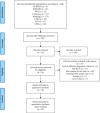A Systematic Review and Meta-Analysis of Acupuncture Treatment for Oral Ulcer
- PMID: 36397997
- PMCID: PMC9666018
- DOI: 10.1155/2022/6082179
A Systematic Review and Meta-Analysis of Acupuncture Treatment for Oral Ulcer
Abstract
Background: Oral ulcer (OU) is a common oral mucosal disease manifested with obvious pain. In some studies, the efficacy of acupuncture in OU has been confirmed, but systematic reviews and meta-analyses for them are lacking. Our aim is to evaluate the efficacy of acupuncture in the treatment of OU.
Methods: We searched the literature from eight databases from their inception to December 2021. We included randomized controlled trials of acupuncture for the treatment of oral ulcer. The meta-analysis was carried out using Review Manager 5.3 and Stata 16.0. The main outcomes were the effective rate and the recurrence rate, the secondary outcomes were the visual analogue score (VAS) and the ulcer healing time.
Results: Totally, 18 studies were finally included in the meta-analysis, including 1,422 patients. In meta-analyses, we found that in comparison with Western medicine, acupuncture can improve effective rate (OR = 5.40, 95% CI: 3.40 to 8.58), reduce the ulcer recurrence rate (OR = 0.21, 95% CI: 0.13 to 0.33), and relieve the ulcer pain (MD = -2.26, 95% CI: -4.27to-0.24). In addition, compared with Western medicine, acupuncture plus Western medicine also can improve effective rate (OR = 2.95, 95% CI: 1.48 to 5.85). Compared with the Chinese medicine, the acupuncture plus Chinese medicine can improve the effective rate (OR = 8.26, 95% CI: 3.61 to 18.88) and relieve the ulcer pain (MD = -1.85, 95% CI: -2.51 to -1.19).
Conclusion: Acupuncture may be more effective than Western medicine in terms of efficacy rate, and acupuncture combined with Western or Chinese medicine may have the potential to reduce the recurrence of ulcer and relieve the ulcer pain. However, due to limited evidence, higher quality and more rigorously designed clinical trials with larger sample sizes will be needed to further confirm our findings.
Copyright © 2022 Hang Yan et al.
Conflict of interest statement
The authors declare that they have no conflicts of interest.
Figures











Similar articles
-
[Systematic Evaluation and Meta-analysis on Acupuncture for Peptic Ulcer].Zhen Ci Yan Jiu. 2017 Jun 25;42(3):275-82. Zhen Ci Yan Jiu. 2017. PMID: 29071989 Chinese.
-
A systematic review and meta-analysis of acupuncture treatment for oral ulcer.Medicine (Baltimore). 2020 Jul 17;99(29):e21314. doi: 10.1097/MD.0000000000021314. Medicine (Baltimore). 2020. PMID: 32702927 Free PMC article.
-
Efficacy and Safety of Acupuncture in Renal Colic Caused by Urinary Calculi in Adults: A Systematic Review and Meta-Analysis.Evid Based Complement Alternat Med. 2022 Jul 4;2022:7140038. doi: 10.1155/2022/7140038. eCollection 2022. Evid Based Complement Alternat Med. 2022. PMID: 35832526 Free PMC article. Review.
-
The Effectiveness of Acupuncture for Osteoporosis: A Systematic Review and Meta-Analysis.Am J Chin Med. 2018;46(3):489-513. doi: 10.1142/S0192415X18500258. Epub 2018 Apr 4. Am J Chin Med. 2018. PMID: 29614884
-
Treatment of knee osteoarthritis with acupuncture combined with Chinese herbal medicine: a systematic review and meta-analysis.Ann Palliat Med. 2021 Nov;10(11):11430-11444. doi: 10.21037/apm-21-2565. Ann Palliat Med. 2021. PMID: 34872268
Cited by
-
Network pharmacology and molecular docking-based investigation on traditional Chinese medicine Astragalus membranaceus in oral ulcer treatment.Medicine (Baltimore). 2023 Aug 25;102(34):e34744. doi: 10.1097/MD.0000000000034744. Medicine (Baltimore). 2023. PMID: 37653793 Free PMC article.
-
Clinical efficacy of recombinant human basic fibroblast growth factor combined with ranitidine in the treatment of recurrent oral ulcer and its effect on serum TNF, IL-2 and T-lymphocyte subsets.Pak J Med Sci. 2024 Mar-Apr;40(4):679-684. doi: 10.12669/pjms.40.4.7881. Pak J Med Sci. 2024. PMID: 38545030 Free PMC article.
-
Soluble epoxide hydrolase inhibitor promotes the healing of oral ulcers.Clinics (Sao Paulo). 2023 May 4;78:100208. doi: 10.1016/j.clinsp.2023.100208. eCollection 2023. Clinics (Sao Paulo). 2023. PMID: 37148830 Free PMC article.
References
Publication types
LinkOut - more resources
Full Text Sources

